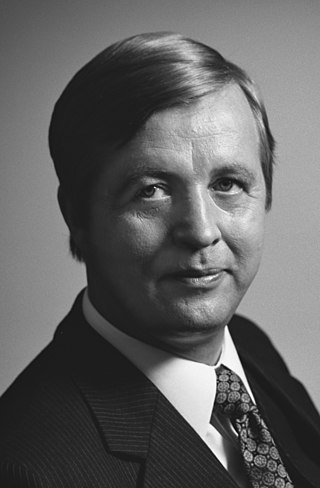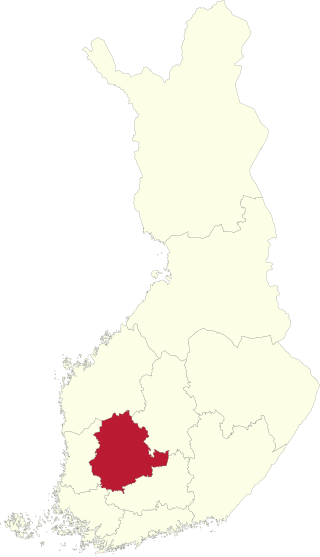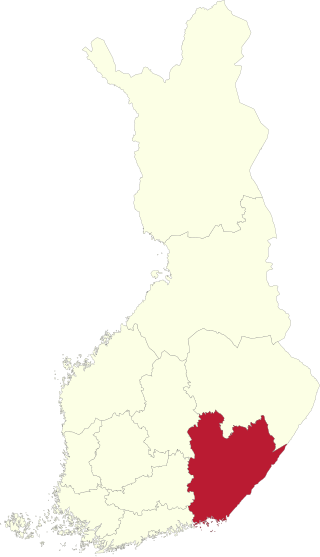
Taisto Kalevi Sorsa was a Finnish politician who served as Prime Minister of Finland three times: 1972–1975, 1977–1979 and 1982–1987. At the time of his death he still held the record for most days of incumbency as prime minister. He was also a long-time leader of the Social Democratic Party of Finland.

Varsinais-Suomi is one of the 13 electoral districts of the Parliament of Finland, the national legislature of Finland. The district was established as Turku and Pori Province South in 1907 when the Diet of Finland was replaced by the Parliament of Finland. It was renamed Varsinais-Suomi in 1997. It is conterminous with the region of Southwest Finland. The district currently elects 17 of the 200 members of the Parliament of Finland using the open party-list proportional representation electoral system. At the 2023 parliamentary election it had 398,903 registered electors.

Helsinki is one of the 13 electoral districts of the Parliament of Finland, the national legislature of Finland. The district was established as Helsinki City in 1954 from parts of Uusimaa Province. It was renamed Helsinki in 1997. It is conterminous with the municipality of Helsinki. The district currently elects 23 of the 200 members of the Parliament of Finland using the open party-list proportional representation electoral system. At the 2023 parliamentary election it had 546,375 registered electors.

Central Finland is one of the 13 electoral districts of the Parliament of Finland, the national legislature of Finland. The district was established as Vaasa Province East in 1907 when the Diet of Finland was replaced by the Parliament of Finland. It was renamed Central Finland Province in 1960 and Central Finland in 1997. It is conterminous with the region of Central Finland. The district currently elects 10 of the 200 members of the Parliament of Finland using the open party-list proportional representation electoral system. At the 2023 parliamentary election it had 226,335 registered electors.

Oulu is one of the 13 electoral districts of the Parliament of Finland, the national legislature of Finland. The district was established as Oulu Province South in 1907 when the Diet of Finland was replaced by the Parliament of Finland. It was renamed Oulu Province in 1939 and Oulu in 1997. It is conterminous with the regions of Kainuu and North Ostrobothnia. The district currently elects 18 of the 200 members of the Parliament of Finland using the open party-list proportional representation electoral system. At the 2023 parliamentary election it had 393,643 registered electors.

Pirkanmaa is one of the 13 electoral districts of the Parliament of Finland, the national legislature of Finland. The district was established as Häme Province North in 1907 when the Diet of Finland was replaced by the Parliament of Finland. It was renamed Pirkanmaa in 1997. It is conterminous with the region of Pirkanmaa. The district currently elects 20 of the 200 members of the Parliament of Finland using the open party-list proportional representation electoral system. At the 2023 parliamentary election it had 437,155 registered electors.

Satakunta is one of the 13 electoral districts of the Parliament of Finland, the national legislature of Finland. The district was established as Turku and Pori Province North in 1907 when the Diet of Finland was replaced by the Parliament of Finland. It was renamed Satakunta in 1997. It is conterminous with the region of Satakunta. The district currently elects eight of the 200 members of the Parliament of Finland using the open party-list proportional representation electoral system. At the 2023 parliamentary election it had 176,653 registered electors.

Häme is one of the 13 electoral districts of the Parliament of Finland, the national legislature of Finland. The district was established as Häme Province South in 1907 when the Diet of Finland was replaced by the Parliament of Finland. It was renamed Häme in 1997. It is conterminous with the regions of Kanta-Häme and Päijät-Häme. The district currently elects 14 of the 200 members of the Parliament of Finland using the open party-list proportional representation electoral system. At the 2023 parliamentary election it had 310,047 registered electors.

Uusimaa is one of the 13 electoral districts of the Parliament of Finland, the national legislature of Finland. The district was established as Uusimaa Province in 1907 when the Diet of Finland was replaced by the Parliament of Finland. It was renamed Uusimaa in 1997. It is conterminous with the region of Uusimaa but excludes the municipality of Helsinki which has its own electoral district. The district currently elects 37 of the 200 members of the Parliament of Finland using the open party-list proportional representation electoral system. At the 2023 parliamentary election it had 801,205 registered electors.

Vaasa is one of the 13 electoral districts of the Parliament of Finland, the national legislature of Finland. The district was established in 1960 by the merger of Vaasa Province North and Vaasa Province South districts. It is conterminous with the regions of Central Ostrobothnia, Ostrobothnia and South Ostrobothnia. The district currently elects 16 of the 200 members of the Parliament of Finland using the open party-list proportional representation electoral system. At the 2023 parliamentary election it had 365,027 registered electors.
Parliamentary elections were held in Finland on 20 and 21 March 1966. The Social Democratic Party (SDP) overtook the Centre Party as the largest faction in Parliament. Rafael Paasio of the SDP subsequently became Prime Minister and formed a popular front government consisting of the SDP, the Centre Party, the People's Democratic League (SKDL), and the Social Democratic Union of Workers and Smallholders (TPSL) in May 1966.
Parliamentary elections were held in Finland on 18 and 19 March 1979.
Parliamentary elections were held in Finland on 15 and 16 March 1987.

Parliamentary elections were held in Finland on 17 March 1991, the first time a Finnish parliamentary election had been held on a single day. For the first time since 1962 the Social Democratic Party was displaced as the largest party in the Eduskunta, with the Centre Party winning 55 seats and forming the first centre-right, non-social democratic government since 1964, with Esko Aho as Prime Minister.

Parliamentary elections were held in Finland on 19 March 1995.

Karl-August Fagerholm's third cabinet, also known as the Night Frost Cabinet or the Night Frost Government, was the 44th government of Republic of Finland, in office from August 9, 1958 to January 13, 1959. It was a majority government. The cabinet was formed after the parliamentary election of 1958.

Presidential elections were held in Finland in 1988. They were the first elections held under a new system. Previously, the public had elected an electoral college that in turn elected the President. For this election, the public directly elected the President on 31 January and 1 February, but also elected an electoral college that would elect the President if no candidate won over 50% of the popular vote. The college was increased in size from 300 to 301 seats to make a tie less likely, though this was still technically possible, as electors could abstain from voting.

Southeast Finland is one of the 13 electoral districts of the Parliament of Finland, the national legislature of Finland. The district was established in 2013 by the merger of Kymi and South Savo districts. It is conterminous with the regions of Kymenlaakso, South Karelia and South Savo. The district currently elects 15 of the 200 members of the Parliament of Finland using the open party-list proportional representation electoral system. At the 2023 parliamentary election it had 353,468 registered electors.

Savo-Karelia is one of the 13 electoral districts of the Parliament of Finland, the national legislature of Finland. The district was established in 2013 by the merger of North Karelia and North Savo districts. It is conterminous with the regions of North Karelia and North Savo. The district currently elects 15 of the 200 members of the Parliament of Finland using the open party-list proportional representation electoral system. At the 2023 parliamentary election it had 343,887 registered electors.
























